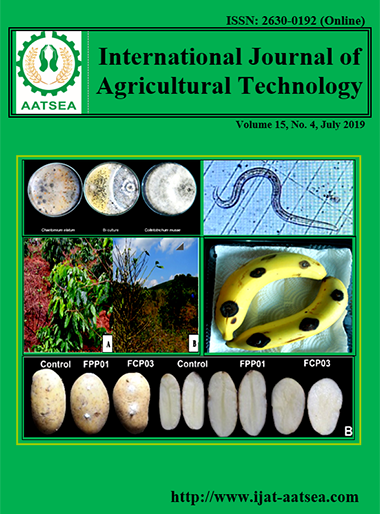Evaluation of bio-formulation from Chaetomium elatum ChE01 to control banana anthracnose caused by Colletotrichum musae
Main Article Content
Abstract
Anthracnose of banana is proved to cause by Colletotrichum musae. Chaetomium elatum ChE01 inhibited the growth of C. musae within 30 days in bi-culture plates over 60 % and inhibited the spore production of C. musae of 57 %. The metabolites from C. elatum ChE01 actively fungal activity against C. musae for spore inhibition which crude methanol, crude ethyl acetate and crude hexane extracts at the ED50 value was 5.43, 7.43 and 19.62 ppm., respectively. The new bio-formulation of C. elatum ChE01 reduced disease incidence of banana anthracnose of 13.34 % compared to benomyl that reduced the disease incidence of 13.05 %. Moreover, the crude extract mixture of C. elatum ChE01 and spore suspension of C. elatum ChE01 reduced the anthracnose incidence of 2.13 and 2.04 %, respectively. The research finding is reported for the first time that bioformulations of C. elatum ChE01 could control banana anthracnose caused by C. musae.
Article Details

This work is licensed under a Creative Commons Attribution-NonCommercial-NoDerivatives 4.0 International License.
References
Center for Agriculture Information Office of Agricultural Economic (2012). Ministry of Agriculture and Co-0perstive, Thailand. Retrieved from http://www.oae.go.th/download/- journal/trade56.pdf.
De Lapeyre de Bellaire, L. and Dubois, C. (1997). Distribution of thiabendazole‐resistant Colletotrichum musae isolates from Guadeloupe banana plantations. Plant Disease, 81:1378-82.
Domsch, K. H., Gams, W. and Anderson, T. W. (1980). Compendium of Soil Fungi. Academic Press, London, pp.860.
Finlay, A. R. and Brown, A. E. (1993). The relative importance of Colletotrichum musae as a crown rot pathogen on Windward Island bananas. Plant Pathology, 42:67-74.
Food and Agriculture Organization of the United Nation (2006). Retrieved from http://www.fao.orges/ESC/en/15/190/index.html.
Green, G. L. and Goos, R. D. (1963). Fungi associated with crown rot of boxed bananas. Phytopathology, 53:271-5.
Griffee, P. J. and Burden, O. J. (1974). Incidence and control of Colletotrichum musae on bananas in the Windward Islands. Annals of Applied Biology, 77:11-6.
Griffee, P. J. and Burden, O. J. (1976). Fungi associated with crown rot of boxed bananas in the Windward Islands. Phytopathologische Zeitschrift, 85:206-16.
Pornsuriya, C., Lin, F. C., Kanokmedhakul, S. and Soytong, K. (2008). New record of Chaetomium species isolated from soil under pineapple plantation in Thailand. Journal of Agricultural Technology, 4:91-103.
Sakunyarak, K. and Satithorn, W. (2014). Evaluation of antagonistic bacteria inhibitory to Colletotrichum musae on banana. International Journal of Agricultural Technology, 10:383- 390.
Song, J. J. and Soytong, K. (2016). Antifungal activity of Chaetomium elatum against Pyricularia oryze causing rice blast. International Journal of Agricultural Technology, 12:1437-1447.
Soytong, K. (2001). Specie of Chaetomium in Thailand soils. Thai Phytopathology, 11:80-84.
Soytong, K. (2015). Testing bioformulation of Chaetomium elatum ChE01to control Fusarium wilt of tomato. Journal of Agricultural Technology, 11:975-996.
Su, Yuan-Ying, Noireung, P., Liu, F. and Hyde, K. D. (2011). Epitypification of Collewtotrichum musae, the causative agent of banana anthracnose. Mycoscience, 56:376-382.
Thohinung, S., Kanokmedhakul, S., Kanokmedhakul, K., Kukongviriyapan, V., Tusskorn, O. and Soytong, K. (2010). Cytotoxic 10-(indol-3-yl)-[13] cytochalasans from the fungus Chaetomium elatum ChE01. Archives of Pharmacal Research, 33:1135-1141.
Von Arx, J. A., Guarro, J. and Funguer, M. J. (1986). The ascomycetes Genus Chaetomium. Nova Hedwigia, 48:1-162.
Zhimo, V. Y., Bhutia, D. D. and Saha, J. (2016). Biological control of postharvest fruit diseases using antagon istic yeasts in India. Journal of Plant Pathology, 98:275-283.


